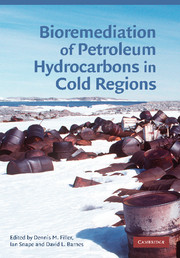Book contents
- Frontmatter
- Contents
- List of contributors
- Preface
- Glossary
- 1 Contamination, regulation, and remediation: an introduction to bioremediation of petroleum hydrocarbons in cold regions
- 2 Freezing and frozen soils
- 3 Movement of petroleum through freezing and frozen soils
- 4 Hydrocarbon-degrading bacteria in contaminated cold soils
- 5 Temperature effects on biodegradation of petroleum contaminants in cold soils
- 6 Analytical methods for petroleum in cold region soils
- 7 Treatability studies: microcosms, mesocosms, and field trials
- 8 Nutrient requirements for bioremediation
- 9 Landfarming
- 10 Thermally enhanced bioremediation and integrated systems
- 11 Emerging technologies
- References
- Index
8 - Nutrient requirements for bioremediation
Published online by Cambridge University Press: 22 August 2009
- Frontmatter
- Contents
- List of contributors
- Preface
- Glossary
- 1 Contamination, regulation, and remediation: an introduction to bioremediation of petroleum hydrocarbons in cold regions
- 2 Freezing and frozen soils
- 3 Movement of petroleum through freezing and frozen soils
- 4 Hydrocarbon-degrading bacteria in contaminated cold soils
- 5 Temperature effects on biodegradation of petroleum contaminants in cold soils
- 6 Analytical methods for petroleum in cold region soils
- 7 Treatability studies: microcosms, mesocosms, and field trials
- 8 Nutrient requirements for bioremediation
- 9 Landfarming
- 10 Thermally enhanced bioremediation and integrated systems
- 11 Emerging technologies
- References
- Index
Summary
Introduction
Nutrients are required to support biological activity, and hence bioremediation. It is recognized that, although the microbial community requires numerous nutrients, nitrogen and phosphorus are the nutrients most often lacking, and thus limiting to biological hydrocarbon degradation in cold region soils (Mohn and Stewart 2000). Numerous studies have reported that biodegradation of hydrocarbon contaminants in cold region soils has been enhanced by the addition of one or both of these nutrients (Walworth and Reynolds 1995; Braddock et al. 1997; Walworth et al. 1997; Braddock et al. 1999; Mohn and Stewart 2000; Mohn et al. 2001; Ferguson et al. 2003a).
Nitrogen most often provides positive responses, although methodologies for determining application levels are not well defined. Proper nitrogen management can increase cell growth rate (Hoyle et al. 1995), decrease the microbial lag phase (Lewis et al. 1986; Ferguson et al. 2003a), help to maintain populations at high activity levels (Lindstrom et al. 1991), and increase the rate of hydrocarbon degradation (Braddock et al. 1997; Braddock et al. 1999). Whereas many studies indicate positive effects of supplemental nitrogen (Rasiah et al. 1991; Allen-King et al. 1994; Walworth and Reynolds 1995), a surprisingly large number report no benefit, or even deleterious effects when excessive levels of nitrogen are applied (Watts et al. 1982; Brown et al. 1983; Huntjens et al. 1986; Morgan and Watkinson 1990; Genouw et al. 1994; Zhou and Crawford 1995; Braddock et al. 1997; Walworth et al. 1997; Braddock et al. 1999; Mohn et al. 2001; Ferguson et al., 2003a).
- Type
- Chapter
- Information
- Bioremediation of Petroleum Hydrocarbons in Cold Regions , pp. 154 - 169Publisher: Cambridge University PressPrint publication year: 2008
- 5
- Cited by



